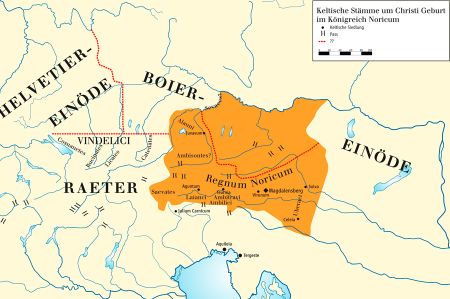Noricum - a Celtic kingdom in today's Austria
- Written by Portal Editor
Noricum was once a Celtic kingdom under the leadership of the Noric tribe on a large part of the territory of present-day Austria as well as adjacent regions of Bavaria (east of the Inn) and Slovenia, which later became a province of the Roman Empire under the designation Provincia Noricum.
The province of Noricum was bordered to the south by Italy, to the east by Pannonia, and to the west by Raetia. The location of the early capital Noreia is still unknown. In Roman times Virunum (now Zollfeld near Maria Saal) was created as capital.
The population of the time of Hallstadt-era was assimilated by the immigration of Celtic population elements from the Celtic core area (south-west Germany and eastern France) about 450 BC. About 200 BC, under the leadership of the Norics, thirteen tribes joined the kingdom of Noricum. Thus the Regnum Noricum was the first political "state structure" at all on Austrian soil. Eight of the 13 tribes of Noricum are known by the excavations on the Magdalensberg: Ambidraven, Ambilines, Ambitious, Helvetian ("Elveti"), Laianken, Noriker, Saevaten and Uperaken.
Later then 200 BC the Celts of Noricum were called to the most important tribe as Taurisker or Noriker (Caesar) by the Romans. The population increased rapidly as a result of improved methods of cultivation and technological progress (eg by the iron ploughshare). The land deficiency was exploding till 186 BC, so pressing was growing too, that 12,000 Tauriskians and Boers emigrated to Italy to the Adriatic. Rome was able to prevent the founding of a city in Friuli, but some of the Celts settled in the Po Valley and the coast of today's Veneto.
Five years later, the Romans founded Aquileia, starting from a military colony. The city was to be of great importance for alpine transhumance. The Romans formed friendly bonds with the Tauriskers of Noricum. They were also given access to the iron deposits of Regnum Noricum.
In 170 BC, as Titus Livius relates, a Roman legation was negotiating with the tribal alliance. From this time, King Cincibilus was in a friendly relationship with the Romans through a "hospitium publicum" (state hospitality). As a result, good trade relations developed and Rome's influence increased. The center of Regnum Noricum was presumably the settlement on the Magdalensberg (later Virunum), a spring-Roman inscription found there, the names of the eight celtic tribes known to us. In the 2nd century BC, the fortified central places (oppida) was beeing built. Norian coins were shaped according to Greek models. In the 1st century BC, The Regnum Noricum reached its greatest extent east and north. Economic foundations were iron (nor iron), mining, industry, agricultural products and trade.
About 120-115 BC, the Germanic tribes of the Cimbers, Ambrones, and Teutones, who had previously been repulsed by the Boers in the Bohemian kettle, the Skordiskers in the Balkans, and finally by the Tauriskernes, fell into Noricum. In the year 113 BC, one Roman army suffered a crushing defeat at Noreia, whereupon the invaders left Noricum and moved westward. By the pressure of the Germans, especially the Sueben, the Boers were in the north and north-east of the Boer in the vicinity of the later Regnum Vannianum-Marchfeld, Weinviertel, Wiener Becken, and Pressburg was their most important oppidum. By 58 BC, the Boers attempted to conquer Noricum, but suffered a crushing defeat. In the pact with the Tauriskern they threatened Noricum for years, until their realm was destroyed by the Dacians.
In the year 49 BC, The celtic king Voccio Caesar sent auxiliary troops for the civil war. As a result of the defeat of the Boiers against the Dacians, the Danube region was annexed or brought into dependence; Noricum's power extended to the Vienna basin and to West Hungary. Thus the Noriks succeeded the last supregional power formation of the mainland deltas.
Two notable kings of the kingdom of Noricum are Cincibilus, a friendship treaty with the Romans, and the Celtic king Voccio, who married his sister to the German prince Ariovist. The latter is mentioned in the Gallic War, since he provided Caesar with 300 riders for the fight.
Noricum was founded as part of the Roman Empire under Emperor Augustus in 15 BC. At first, it retained a limited autonomy as a tributary principality, but under Emperor Claudius (41-54 AD) it became a Roman province.
It included the present-day Austrian provinces of Carinthia, Salzburg, Upper Austria, Lower Austria and Styria as well as the south-east of Bavaria with the Chiemgau. Moreover, parts of Tyrol belonged to it. To the north, the Celtic kingdom, in contrast to the later Roman province, extended beyond the Danube. It was only under the rule of Rome that the Danube formed the frontier of the empire and thus of the province.
Please read as well:
